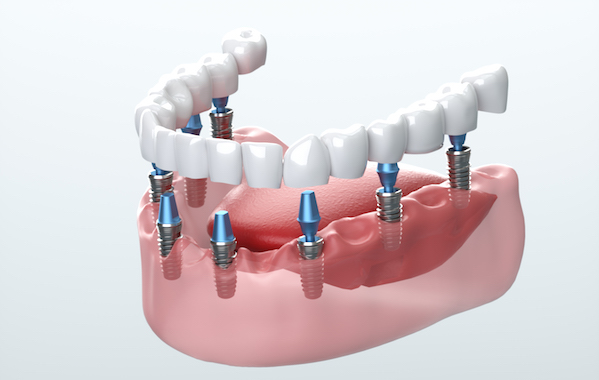The Buzz on Dental Implants
The Of Dental Implants
Table of ContentsSome Known Details About Dental Implants The Definitive Guide to Dental ImplantsMore About Dental ImplantsDental Implants for Dummies
are medical tools surgically dental implanted right into the jaw to bring back an individual's capability to eat or their look. They offer assistance for fabricated (fake) teeth, such as crowns, bridges, or dentures. When a tooth is shed due to injury or condition, a person can experience issues such as quick bone loss, malfunctioning speech, or modifications to chewing patterns that lead to pain.
Framework of The Oral Implant System selecting dental implants, speak to your oral company about the possible benefits and risks, and whether you are a candidate for the procedure. Points to consider: Your general health and wellness is an essential element in identifying whether you are an excellent candidate for oral implants, the length of time it will take to heal, and for how long the dental implant may remain in place.
Smoking cigarettes might impact the healing procedure and lower the lasting success of the implant. The recovery procedure for the dental implant body might take a number of months or longer, during which time you usually have a short-lived abutment in place of the tooth. the dental implant procedure: Carefully comply with the dental health guidelines provided to you by your oral provider.
The Best Strategy To Use For Dental Implants
Implant failure can lead to the requirement for an additional surgical procedure to fix or replace the dental implant system. Recovers the ability to chew Recovers aesthetic appearance Assists maintain the jawbone from reducing as a result of bone loss Maintains the health of the surrounding bone and periodontals Assists keep adjacent (nearby) teeth secure Enhances high quality of life Damages to surrounding all-natural teeth throughout implant placement Injury to the surrounding cells throughout surgical treatment, such as sinus opening Injury throughout surgery (for example, crack of surrounding jawbone) Poor function, such as really feeling like the teeth do not bite together normally A sensation that the tooth is loose or twisting in place arising from an abutment screw loosening Implant body failure (looseness of the dental implant body) due to systemic infection, which might be more probable in individuals with unchecked diabetes mellitus due to regional infection in bone and periodontals supporting the implant body due to delayed healing, which might be more probable in clients who smoke Trouble cleaning up the periodontals around the implant, causing bad oral health Without treatment periodontal illness Post-surgical pins and needles as a result of nerve impingement or damage Constantly notify healthcare service providers and imaging service technicians that you have dental implants before any kind of magnetic resonance imaging (MRI) or x-ray procedures.
FDA is not knowledgeable about any type of damaging events reported for MRI or x-ray procedures with oral implants. Dental implants systems are normally made of products that follow global consensus standards of the International Company for Standardization (ISO) or ASTM International. These standards have information of what makes a safe product.
Various other materials such as gold alloys, cobalt-based alloys, titanium alloys, or ceramic materials are sometimes made use of. The security profiles of these materials are widely known. Oral implant systems are evaluated according to international agreement requirements. Biocompatibility testing, to reveal that bodily contact with the gadget does not create problems like irritability or allergy, belongs to the assessment that helps make certain the products in the oral implant system are risk-free and do not trigger negative results when implanted in individuals.

Little Known Facts About Dental Implants.
Some people are not qualified for look at here dental implant surgical treatment. It is for dental doctors to run on people with: intense illnessuncontrollable metabolic diseasebone or soft tissue illness or infectionIf these concerns are settled, an individual can have the surgery. Dental Implants. In, oral doctors avoid running on individuals with: If people with any one of the above undergo oral implant surgery, there is a greater danger of the implant stopping working
Some individuals have a jawbone irregularity that stops sufficient bone for a dental implant from developing. In such cases, a doctor may require to do a ridge modification. This entails raising the periodontal to expose the location of flawed bone. The doctor will certainly then utilize a bone or bone substitute to fix and construct up the area.
Oral implant surgery is a customized procedure. It's not the same for everybody. The following provides a general summary of what you can anticipate your dentist, dental cosmetic surgeon, periodontist or prosthodontist to do: click now Position the implant operatively. Provide you time to recover. Connect the message and final crown, bridge or denture.
Next off, your specialist will thoroughly position the dental implant right into your jaw. Your cosmetic surgeon will certainly rearrange your gums and close the cut with stitches (Dental Implants). If your dental implant is near the front of your mouth, your dental professional will certainly make a short-lived tooth for you to wear up until you heal. That means, you will not have a gap in your smile while you recover.
Not known Facts About Dental Implants
Your company can tell you what to expect in your circumstance. During the healing phase, your jawbone should fuse to the dental implant. This process, called osseointegration, is crucial for security and lasting success. This process can take anywhere from 3 to nine months. In some cases, it might take longer.
Once your dental implant heals, your dental practitioner can affix the abutment (small adapter article) and your final restoration (crown, bridge or denture). This usually takes concerning one hour to complete and may require a 2nd minor surgery. You should not feel any kind of discomfort during your oral implant procedure due to the fact that your provider will certainly use drug to numb your periodontals.